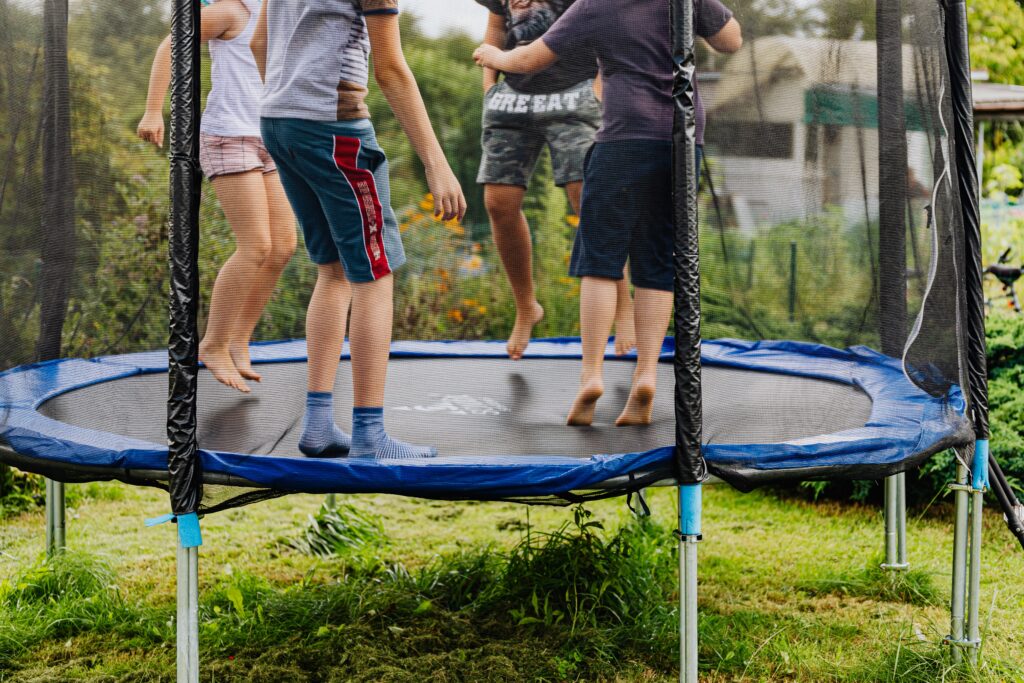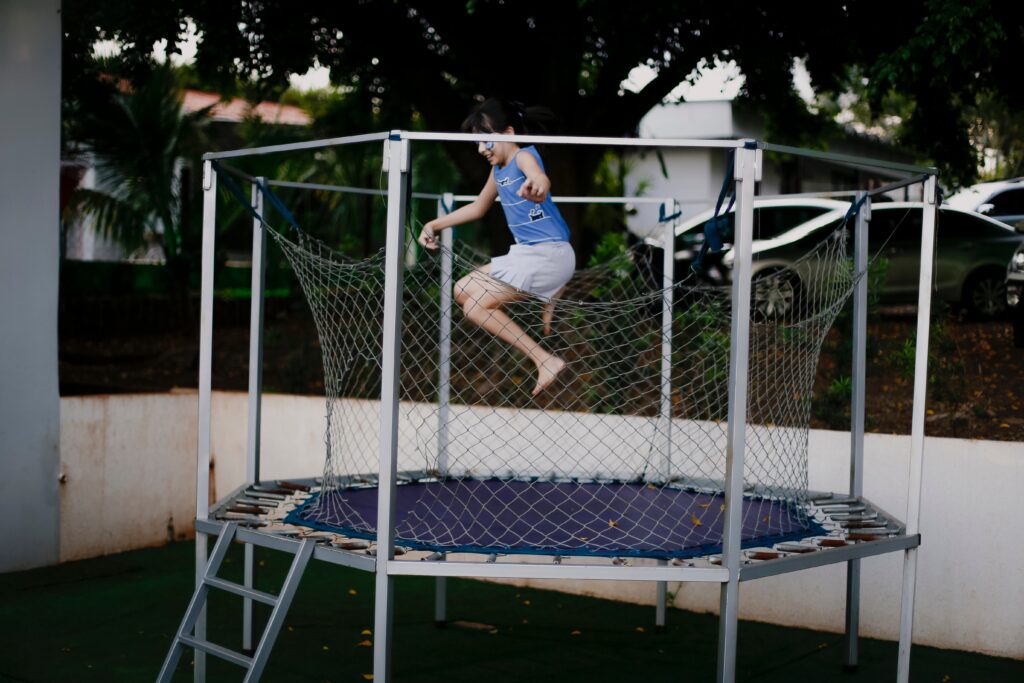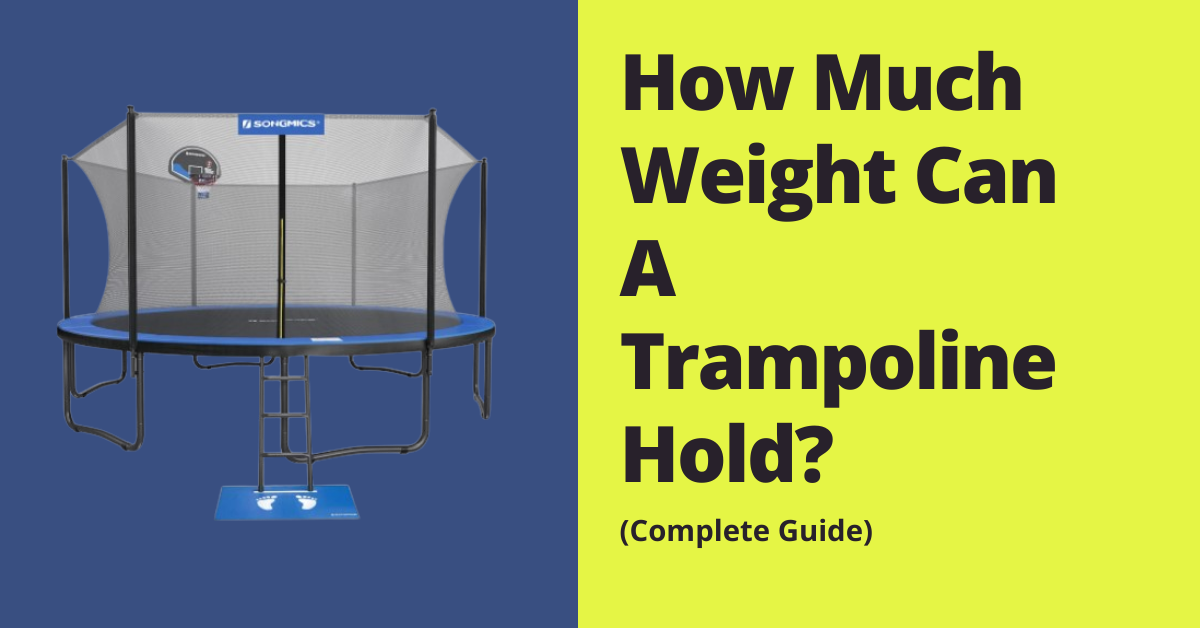How Much Weight Can A Trampoline Hold?
Trampolines are fun until someone bounces too high and comes down hard on the metal frame of the trampoline. When that happens, the frame bends, and the springs pop out. Then it’s called trampoline abuse, which can lead to injury because there is no longer any protection for people jumping on the trampoline. Read more about how to set up or put together a trampoline.
So, the question is, how much weight can a trampoline hold? A trampoline’s weight limit is critical because it can help keep people safe while jumping on the trampoline.

Trampolines aren’t made of solid steel. They have springs, fabric, and padding. All these things combined are what give a trampoline its strength. How much weight a trampoline can hold also varies depending on the size, material, and style.
Why Do Trampolines Have Weight Limits?
Manufacturers put weight limits on trampolines for safety reasons. A child who weighs 30 pounds bounces differently than a 350-pound man. The child is not as big or strong, so he does not have the same effect on the springs and frame of a mini-trampoline. However, the 350-pound man will exert more force on the trampoline. This means it can potentially break sooner than expected.
Injuries from trampolines have been on the rise because many people bring their outdoor trampolines inside during the winter months. They think it will be a fun way to keep their kids active indoors during the cold months.

It’s not as much fun when kids bounce with an adult, and the weight limit is quickly reached because two people are on one trampoline. The potential for injury increases significantly because of this – especially when they accidentally collide midair and fall off the trampolines together.
It’s easy to think that the trampoline is strong enough because you have used it without any problems before. But it’s hard to predict whether or not your weight combined with another person’s weight will be more than what the trampoline can handle.
How Much Weight Can A Trampoline Hold?
The factors that will help you determine how much weight the trampoline can hold are:
Size of Trampolines
Size is the first factor that determines a weight limit. The smaller the springs, the less distance they have to stretch. A mini-trampoline can hold more weight than a large one because of its smaller springs.
A mini-trampoline has small springs stretched to their limit, so they cannot extend very far. This limits how much weight the trampoline can handle. The force exerted on the trampoline is measured in pounds per square foot or psi.
A larger trampoline will have bigger springs with more space between each coil. These coils give a trampoline its bounce, so the bigger the coil is, the higher it will allow someone to jump.
When you bring a large trampoline inside for winter fun, you are putting all your weight on each square inch of spring. Since larger trampolines have larger coils, more force is exerted on them because more weight is on each of the springs.
Material Used
Trampolines can be made of different materials, which affects their weight limit.
Atlas steel springs are the strongest, so trampolines with these springs have the highest weight limits. Trampoline mesh can tear or rip, which decreases its strength no matter what material it is made from. Cotton thread stitching can also weaken the material, especially when it comes in contact with sand.
Steel coils are better than other materials because they can hold more weight without breaking. They are made to last for years and withstand spring tension under heavy weight.
Jumping Surface
The jumping surface can also affect the weight limit because it comes into contact with people’s weight and pressure.
Padded vinyl covers tend to tear more quickly than other materials, so they can be a safety concern for those who bounce vigorously. The padding softens the impact of landings but does not prevent them from happening. It cannot take as much weight and pressure as other materials can.
Trampolines with metal springs must be covered with a solid material to handle the weight load, like vinyl, without tearing or ripping quickly.
Style Of Trampoline
There are different styles of trampolines that have other weight limits because of their design.
Springless trampolines are great for children because they are soft and gentle on their small joints. You can use them inside or outside, but you should not be able to bounce very high. There is no coil support system underneath the jumping surface, so there is less weight supported overall, but the jumping surface can break more easily.
This trampoline style is best for children who do not know how to jump at a high level because there are no springs where they can snag their clothing or hands if they land too close. The soft bounce will reduce the chance of injuries from accidental falls, but it will not support heavy jumping.

Spring-to-coil trampolines can hold the most weight. This style is made with steel springs and cotton thread stitching which holds it together. Since there are so many coils, this trampoline has the highest weight limit because more springs support the weight.
If you are looking for the safest trampoline you can buy, choose one with steel springs. Many companies will not release weight limit information because it is so high, which means you cannot trust other materials to hold your weight.
Frequently Asked Questions
Conclusion
A trampoline should have a higher weight limit than the average person to ensure safety during use. You should not be able to jump very high on a trampoline with a low weight limit because it can break under your weight.
If you weigh less than 220 pounds, a 100-pound weight limit will work just fine. The recommended weight limit is 80-100 pounds for children because they are not as strong and do not need a heavy-duty trampoline.
An old rule of thumb is that the weight limit should be 10% of the jumper’s body weight. The American Society for Testing and Materials (ASTM) and the International Association of Trampoline Parks have set guidelines for trampoline manufacturers, so those numbers are what you should look for when shopping around.
Do we hope this article has helped you understand how much weight a trampoline can hold? Now that you know, find quality trampolines for yourself.
